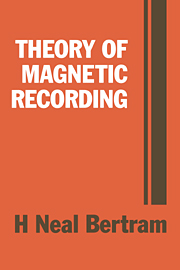Book contents
- Frontmatter
- Contents
- Preface
- 1 Overview
- 2 Review of magnetostatic fields
- 3 Inductive head fields
- 4 Medium magnetic fields
- 5 Playback process: Part 1 – General concepts and single transitions
- 6 Playback process: Part 2 – Multiple transitions
- 7 Magnetoresistive heads
- 8 Record process: Part 1 – Transition models
- 9 Record process: Part 2 – Non-linearities and overwrite
- 10 Medium noise mechanisms: Part 1 – General concepts, modulation noise
- 11 Medium noise mechanisms: Part 2 – Particulate noise
- 12 Medium noise mechanisms: Part 3 – Transition noise
- References and bibliography
- Index
10 - Medium noise mechanisms: Part 1 – General concepts, modulation noise
Published online by Cambridge University Press: 02 February 2010
- Frontmatter
- Contents
- Preface
- 1 Overview
- 2 Review of magnetostatic fields
- 3 Inductive head fields
- 4 Medium magnetic fields
- 5 Playback process: Part 1 – General concepts and single transitions
- 6 Playback process: Part 2 – Multiple transitions
- 7 Magnetoresistive heads
- 8 Record process: Part 1 – Transition models
- 9 Record process: Part 2 – Non-linearities and overwrite
- 10 Medium noise mechanisms: Part 1 – General concepts, modulation noise
- 11 Medium noise mechanisms: Part 2 – Particulate noise
- 12 Medium noise mechanisms: Part 3 – Transition noise
- References and bibliography
- Index
Summary
Introduction
Noise in magnetic recording arises from three predominant sources: the playback amplifier, the playback head, and the recording medium. Amplifier noise depends on current or voltage noise sources. Head noise arises from the loss impedance of the head due to the complex part of the permeability (Figs. 3.2, 3.3). Since the head impedance is matched to the amplifier, inductive head noise results as Johnson noise with the loss impedance as the effective noise resistor (Davenport & Root, 1958). Playback head loss impedance and head noise limited system signal-tonoise ratios have been discussed in detail (Smaller, 1965). In Chapters 10, 11 and 12, analysis of the predominant medium noise mechanisms will be presented. The discussion will focus on calculations of the power spectral density. Measurements of noise spectra can be utilized readily to identify and analyze medium noise sources.
Medium noise arises from fluctuations in the medium magnetization. This noise can be separated into three somewhat distinct sources: amplitude modulation, particulate or granularity noise, and phase or transition noise. An illustration of modulation and transition noise is shown in Figs. 10.1 (a), (b), respectively. In conventional amplitude modulation noise, the fluctuations are proportional to the recorded medium magnetization or flux levels. As the recording density is increased, the noise regions decrease relative to the bit length or transition separation and the noise decreases, as measurements in Fig. 10.2(a) show. Transition noise refers, in general, to fluctuations that are concentrated near the recorded transition centers (Fig. 10.1(b)).
Information
- Type
- Chapter
- Information
- Theory of Magnetic Recording , pp. 261 - 282Publisher: Cambridge University PressPrint publication year: 1994
Accessibility standard: Unknown
- 2
- Cited by
